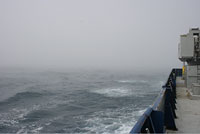

 | |||||||||||||||||
|
|
Journals 2008/2009Jeff Lawrence
December 21, 2008 Oceanographers of today have many more tools at their disposal than at any other time. This technology allows them to gather much more data and analyze it in the field. Aboard the REVELLE there are many different varieties of technology available for the oceanographers to collect samples and data. Some of the equipment for this expedition already existed on board the REVELLE, however a great deal was brought on by the individual scientist from around the planet to use specifically for their purposes. Computers are a valuable resource for a scientist in the field. The REVELLE always has an outside link with the rest of the World. The ship has four cameras that display real-time video of what is occurring on the ship. My students have been able to watch this video at times to see us deploy the CTD, SAPS, and other equipment over the side of the REVELLE. We have use of the Internet, email, and Skype to connect to our students, families, and work places back home. Home for this crew could be the United States, Bermuda, England, South Africa, Italy, or Argentina. Being connected to the outside world allows the science to continue on schedule and with the assistance of others such as NASA who are not aboard. This connection is also good for morale to the crew especially during this holiday season to stay connected with family. Dr. Balch and his group have used current satellite photos from NASA to track where coccolithophore blooms are occurring on the Patagonian Shelf. Plots to water collection stations are adjusted accordingly. The weather is always a factor and with satellite imagery and updated forecast, plans can be made in advance to accommodate weather conditions so the delays are minimal.
Many of the scientists are collecting water samples to filter and then analyze. Some machines analyze for inorganic/organic compounds, nitrates, and dissolved oxygen. Now and then technology can be a little frustrating as shown below on Marlene Jeffries CO2 analyzer. Marlene is bound and determined not to let the Grinch steal Christmas. Marlene and Nicole Benoit work together to collect samples that will be analyzed on board the REVELLE and back in Marlene's home lab in Bermuda. They work tirelessly to collect samples from the CTD cast. Both Marlene and Nicole have to be ready to get their samples from the bottles and be at the front of the line. They take great care in making sure no air bubbles are left in the bottles before they seal them for storage. They are measuring DIC (Dissolved Inorganic Carbon), if oxygen is left in the bottles the carbon in the sample tends to want to escape as a gas and will form in the O2 bubbles. This will lead to inaccurate readings to the amount of carbon in the sample.
Birthdays are always celebrated at sea with a cake from the kitchen. Yesterday was Jack DiTullio's birthday. We have had four or five other birthdays already aboard the ship. The REVELLE's cooks do a terrific job of baking different kinds of cake for each occasion. We all like birthdays on the REVELLE are glad to help the birthday person dispose of the cake.
**Storm is moving through this morning, large swells, impossible to sleep or stay in the bed. It is like being on a roller coaster and now being able to get off. It is hoped that this is a quick moving storm that will not last long. Our luck was bound to run out at sometime, we have had beautiful sailing weather for the first three weeks. However this is the South Atlantic and storms are expected and common. I am on my way to breakfast and hope to be able to catch up with my plate, walking is a little difficult on a rolling ship. Questions of the Day:
|
||||||||||||||||



